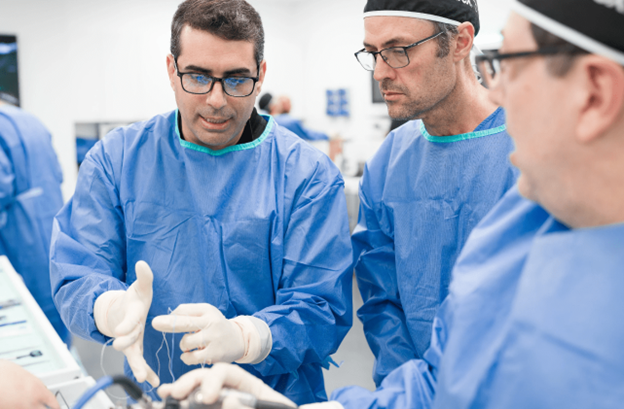

Arthrex’s ongoing sustainability efforts have led to creative – and cost-saving – uses for scrap product at the company’s manufacturing and global logistics facilities.
Manufacturing products, especially in the highly regulated field of medical devices, inevitably leads to scrapped materials. Products may be scrapped for any number of reasons, including products produced during the validating of new machines or new processes, remnants from destructive testing and products that don’t meet Arthrex’s quality standards, even if that means only minor cosmetic defects.

Initiatives from senior leadership to increase sustainability led to the idea of funneling “almost good-enough” devices to Medical Education for training purposes.
Arthrex’s dedication to surgeon training comes with significant costs to the company. The cost is now being offset by products that, in the past, were being scrapped.
“The ultimate goal,” Operational Excellence Senior Manager Justin Mills explained, “is to recover scrap that meets a clinical need but isn’t saleable.”
The cobalt chrome components of the iBalance® UKA System make for a good example. The manufacturing requirements for those pieces mandate that there are no scratches on the surface and that the metal be polished to an almost mirror-like finish.
“It’s a piece that, when implanted, gets slathered in glue and hammered into place,” Justin said. “And yet, only perfect pieces get shipped to our customers.”
Operations Excellence Project Senior Manager I Donna Lamere led a Kaizen event in September with the goal of developing a process for identifying and collecting manufacturing scrap that can be used by Medical Education and implementing a pilot scrap reclamation program. Original estimates from the two-day meeting, which included team members from Operations Excellence, Medical Education, Quality, Manufacturing and Reverse Logistics, predicted $800,000 in savings in the first year, but the project is already on pace to exceed that number.
In addition to reducing Medical Education’s direct expenditure, the new reclamation process also reduces the number of samples that were previously manufactured for training purposes, thus freeing up manufacturing capacity and limiting material usage.
Justin noted that Arthrex’s growth has led to the current need to optimize the handling of scrap.
“If you’re only producing, say, 100 pieces of a given product, scrapping one or two percent of those products is a relatively small number,” said Justin. “But when production numbers increase, the total amount of scrap becomes more significant.”
What, then, happens to scrap products not needed by the Medical Education team?
That’s where partnerships with organizations like Project C.U.R.E. and SIGN Fracture Care International come into play.
For more than two years, Arthrex has partnered with Project C.U.R.E., the world’s largest distributor of donated medical supplies, equipment and services. Donations through Project C.U.R.E are distributed throughout 135 countries, with Arthrex donations largely aiding Ethiopia, Ghana, Kenya, Mexico, Mongolia, Tanzania, Turkey, Ukraine and Zimbabwe.
Because Project C.U.R.E. primarily operates in bulk shipments, the decision was recently made to extend Arthrex’s partnerships to include SIGN Fracture Care, an organization that allows for smaller, more targeted shipments of donated implant systems and the ability to address more specific and urgent requests.
To date, Arthrex has donated more than $1.9 million in costed inventory to Project C.U.R.E. and SIGN, and surgeons from around the world have extended their overwhelming gratitude to Arthrex for the support they have received.
“I, and most of my colleagues, have had trouble performing the work we have trained to do. This was not an issue of lack of skills but availability and cost of resources to take care of our patients,” Paa K. Baidoo, MD (Kumasi, Ghana), said in a letter to Arthrex. “After getting the donation, I made some of my colleagues aware of the donated products, and I’m glad to say that we have performed more ACL repairs, meniscal repairs, rotator cuff repairs, osteotomies around the knee and other surgeries in the past year than we have done cumulatively over the years.”
The majority of the products donated to Project C.U.R.E. and SIGN come from Arthrex’s global logistics center, which generates its own share of scrap as a result of expired products, products with damaged packaging and products that have been obsoleted by newer technology.
“We use what scrap we can internally first,” said Strategic Development Project Manager Amy Giacometti, “and then our humanitarian outreach partners take over in furthering Arthrex’s mission of Helping Surgeons Treat Their Patients Better®.”